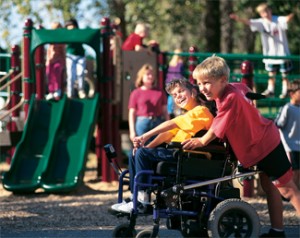Including Children With Disabilities in Life
 It was a beautiful sunny day for a man to be at a playground with his preschool grandchildren. That’s exactly where I was. I took my grandson and grand-daughter to a playground at a nearby elementary school; one child sat on my lap while the other stood on the back of my electric wheelchair as we whizzed our way to the playground.
It was a beautiful sunny day for a man to be at a playground with his preschool grandchildren. That’s exactly where I was. I took my grandson and grand-daughter to a playground at a nearby elementary school; one child sat on my lap while the other stood on the back of my electric wheelchair as we whizzed our way to the playground.
The place was packed with children of various ages having fun at afternoon recess. I had to watch from the safety of the grass because my wheelchair would get bogged down in the soft sand.
“Look at me!” cried my grandson as he hung upside down from the monkey-bars. My wee grand-daughter stood at the top of a slide waiting for me to look at her before she slid down laughing. Zoom! It was so good to be alive and breathe in the fresh October air; it was good to feel the sun’s warmth on my back before a long Canadian winter. To be surrounded by such childhood joy warmed my heart too. Joie de vivre!
Sweet inclusion
Something else made my heart soar. I noticed four children with visible disabilities in the middle of playful mayhem. One child had a withered arm, a second had cerebral palsy, a third with Down’s while a fourth child was deaf. It was good not to see a “program” or “strategy” to include them. It just happened. The children simply took each others’ differences in stride and played together.
I sensed that what was unfolding before my eyes is the way God wants life to be—and children were leading the way! They didn’t need behavioral psychologists or “experts” to show them how to include children with disabilities. They just played.
I also sensed that adults and experts needed the children’s example more than the other way around. We all do.
Some people are very good at ensuring special needs children are part of their communities and included within normal childhood. The school I just mentioned is a shining example. Integrated schools are valuable vehicles to teach acceptance and inclusion of people with disabilities. The able-bodied children of that particular school seem to have incorporated this important life lesson into their daily lives.
Why are so many adults such slow learners? Why do I still hear resistance to integration of children with disabilities into public schools?
Dichotomy of the age
At the same time as some children with disabilities were frolicking with my grandchildren at the playground, other children were dying at the hands of experts. That’s the dichotomy of the age. We can be so enlightened yet so savage toward children with disabilities.
Nearly fifty percent of pregnancies involving babies with spina bifida end with the baby never seeing the light of day. They are aborted. Why are eighty-percent of pregnancies involving Down’s children aborted? Why is that? Why are pregnancies scrutinized — with a search and destroy mindset — for the slightest anatomical or genetic anomaly or imperfection? Disabled newborns are routinely denied nutrition and hydration in hospitals across North America. Why does modern medicine and bioethics believe disabled children are worthless—so worthless they do not deserve life itself?
Tell that to the four children with disabilities I mentioned playing happily in the schoolyard.
I have actually heard some people say it’s unfair to bring a profoundly disabled child into the world. Late feminist icon, Betty Frieden, referred to disabled children in utero as “monstrosities.” She was wrong, so utterly, terribly wrong.
People are not monstrous, ideas are. Deformity or disability can cripple a person’s body or cognitive function. But it is ideas, stone hearted and brutal ideas, that cripple human hearts. It is the logic of darkness and ignorance that stunts the development of character and denies any embrace of love and acceptance to the disabled, the handicapped or the genetically flawed. That may be the way of the world but it is not the way for followers of Jesus. Those who have encountered the living Christ know that all humanity is imperfect, yet still loved by God. God cares about each individual’s development within a larger common good.
Transformation
Real inclusion is concerned about the development of each individual as an integral and indispensable part of a community. Real community understands that every person has something to contribute to the common good. Sometimes that contribution takes the form of simply being present and being welcome.
We must take care never to judge the worth of another human being! That is not our right. Humanity’s social nature calls each of us to take care never to close the door of inclusion on any human life, regardless of their physical or mental state.
Pray for God’s help to transcend beyond a self-focus to become other-focused. Seek to understand more than being understood. Embrace even when your natural inclination is to repel. Be equally concerned about the common good as individual fulfillment. Do this and you will begin to see, unfolding before your very eyes, the way God wants life to be. I’m convinced of it.

